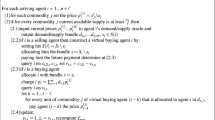Abstract
Markets are important coordination mechanisms for multiagent systems, and market clearing has become a key application area of algorithms. We study optimal clearing in the ubiquitous setting where there are multiple indistinguishable units for sale. The sellers and buyers express their bids via supply and demand curves. Discriminatory pricing leads to greater profit for the party who runs the market than non-discriminatory pricing. We show that this comes at the cost of computation complexity. For piecewise linear curves we present a fast polynomial-time algorithm for nondiscriminatory clearing, and show that discriminatory clearing is NP-complete (even in a very special case). We then show that in the more restricted setting of linear curves, even discriminatory markets can be cleared fast in polynomial time. Our derivations also uncover the elegant fact that to obtain the optimal discriminatory solution, each buyer’s (seller’s) price is incremented (decremented) equally from that agent’s price in the quantity-unconstrained solution.
This work was funded by, and conducted at, CombineNet, Inc., 311 S. Craig St., Pittsburgh, PA 15213.
Access this chapter
Tax calculation will be finalised at checkout
Purchases are for personal use only
Preview
Unable to display preview. Download preview PDF.
Similar content being viewed by others
References
M. de Berg, M. van Kreveld, M. Overmars and O. Schwarzkopf. Computational Geometry: Algorithms and Applications. Springer, 2000.
Y. Fujishima, K. Leyton-Brown, and Y. Shoham. Taming the computational complexity of combinatorial auctions: Optimal and approximate approaches. In Proceedings of the Sixteenth International Joint Conference on Artificial Intelligence (IJCAI), pages 548–553, Stockholm, Sweden, August 1999.
M. R Garey and D. S Johnson. Computers and Intractability. W. H. Freeman and Company, 1979.
H. Hoos and C. Boutilier. Solving combinatorial auctions using stochastic local search. In Proceedings of the National Conference on Artificial Intelligence (AAAI), pages 22–29, Austin, TX, August 2000.
R. Lavi and N. Nisan. Competitive analysis of incentive compatible on-line auctions. In Proceedings of the ACM Conference on Electronic Commerce (ACM-EC), pages 233–241, Minneapolis, MN, 2000.
K. Leyton-Brown, M. Tennenholtz, and Y. Shoham. An algorithm for multi-unit combinatorial auctions. In Proceedings of the National Conference on Artificial Intelligence (AAAI), Austin, TX, August 2000.
W. A Lupien and J. T Rickard. Crossing network utilizing optimal mutual satisfaction density profile. US Patent 5,689,652, granted Nov. 18 to Optimark Technologies, 1997.
A. Mas-Colell, M. Whinston, and J. R. Green. Microeconomic Theory. Oxford University Press, 1995.
M. H Rothkopf, A. Pekeč, and R. M Harstad. Computationally manageable combinatorial auctions. Management Science, 44(8):1131–1147, 1998.
T. Sandholm. eMediator: A next generation electronic commerce server. In Proceedings of the Fourth International Conference on Autonomous Agents (AGENTS), pages 73–96, Barcelona, Spain, June 2000.
T. Sandholm. Algorithm for optimal winner determination in combinatorial auctions. Artificial Intelligence, 135:1–54, January 2002.
T. Sandholm and S. Suri. Market clearability. In Proceedings of the Seventeenth International Joint Conference on Artificial Intelligence (IJCAI), pages 1145–1151, Seattle, WA, 2001.
T. Sandholm, S. Suri, A. Gilpin, and D. Levine. Winner determination in combinatorial auction generalizations. In International Conference on Autonomous Agents and Multi-Agent Systems (AAMAS), Bologna, Italy, July 2002.
P. R Wurman, M. P Wellman, and W. E Walsh. The Michigan Internet AuctionBot: A configurable auction server for human and software agents. In Proceedings of the Second International Conference on Autonomous Agents (AGENTS), pages 301–308, Minneapolis/St. Paul, MN, May 1998.
Author information
Authors and Affiliations
Editor information
Editors and Affiliations
Rights and permissions
Copyright information
© 2002 Springer-Verlag Berlin Heidelberg
About this paper
Cite this paper
Sandholm, T., Suri, S. (2002). Optimal Clearing of Supply/Demand Curves. In: Bose, P., Morin, P. (eds) Algorithms and Computation. ISAAC 2002. Lecture Notes in Computer Science, vol 2518. Springer, Berlin, Heidelberg. https://doi.org/10.1007/3-540-36136-7_52
Download citation
DOI: https://doi.org/10.1007/3-540-36136-7_52
Published:
Publisher Name: Springer, Berlin, Heidelberg
Print ISBN: 978-3-540-00142-3
Online ISBN: 978-3-540-36136-7
eBook Packages: Springer Book Archive




